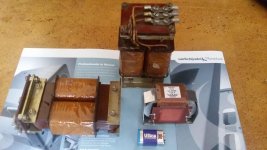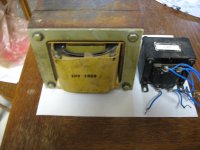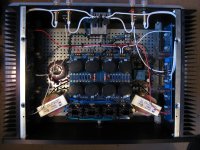Out of interest i tried modeling one half of my F4 supply and replaced the .1r resistor (four .47r in parallel), with a Hammond 159ZJ (10mh, 5A, 0.16r). Only real difference i see is a reduction in ripple from 161mv to 71mv. Might pick a couple up and give them a try.
On a related note, anybody know of a good Hammond supplier in the EU or UK? I used to use tubes.it on ebay but seems they are no longer in business.
Mouser Electronics - Electronic Components Distributor
I got mine from mouser USA, looks like Mouser UK will do free shipping with a minimum order.
Tube town looks good, thanks for that. I found Mouser shipping gets expensive when you add transformers into the basket as most of them are not included under the free shipping.
Ordered two 159ZJ to test, and two big 193C for another project from Tubetown with a very reasonable €15 shipping. I'll post back my finding, if there are any...
You can "look" at this attenuation of ripple on your oscilloscope.Out of interest i tried modeling one half of my F4 supply and replaced the .1r resistor (four .47r in parallel), with a Hammond 159ZJ (10mh, 5A, 0.16r). Only real difference i see is a reduction in ripple from 161mv to 71mv. Might pick a couple up and give them a try.
On a related note, anybody know of a good Hammond supplier in the EU or UK? I used to use tubes.it on ebay but seems they are no longer in business.
You can measure the extra attenuation on the scope.
You can also see the change in shape.
The more "rounded" shape of the CLC ripple tells you there is a lesser contribution of the HF in the ripple.
The sawtooth shape and the sharper, the points the higher the HF contribution in the ripple.
I don't know how to measure this. I can only look and see that it is more rounded.
An FFT should be able to measure the LF and HF content of the ripple.
You guys think a 5A rated choke is enough for say...2.5A per channel of bias? That's why I went with the 2.5mh choke...it's 10A rated. I am not sure, maybe 5A is enough.
Quote from datasheet..
The main reason i chose that model was because the resistance is comparable to the stock resistors.Inductances measured at rated D.C. current. Units will exhibit less inductance at slightly higher currents or more at lower currents.
Quote from datasheet..
The main reason i chose that model was because the resistance is comparable to the stock resistors.
Yea! That means even more inductance (more than 2.5mH) for me.
I've always thought that Pass recommended around 2mH for CLC. I think I read it somewhere a long time ago but I could be remembering it wrong. That's why I went with the 2.5mH chokes. I understand that more inductance smooths out the supply which is desirable. Maybe the 2mH recommendation was because the resistance usually goes up with inductance.
Hello,
Just some chokes that could be used in higher current applications. The lundahl is 1,25 A rated model is available with less mH and higher current. In the Pass amps the voltage across the choke is not big so current can be higher . See the attachment I did post before.
The two big Telefunken chokes have more mH than the lundahl. Higher current capability. They were cheap, about 30$ but I think there is no stock left.
Greetings, Eduard
Just some chokes that could be used in higher current applications. The lundahl is 1,25 A rated model is available with less mH and higher current. In the Pass amps the voltage across the choke is not big so current can be higher . See the attachment I did post before.
The two big Telefunken chokes have more mH than the lundahl. Higher current capability. They were cheap, about 30$ but I think there is no stock left.
Greetings, Eduard
Attachments
Hello,
Did ask a friend in Italy if he already did use or test the big Telefunken choke i send him a few months ago.
Also did ask the shop where i did buy them about his actual stock.
If the man in Italy they are better than the Lundahl ( he has both models shown in my picture) i will of course buy some more for future projects.
Greetings, Edward
Did ask a friend in Italy if he already did use or test the big Telefunken choke i send him a few months ago.
Also did ask the shop where i did buy them about his actual stock.
If the man in Italy they are better than the Lundahl ( he has both models shown in my picture) i will of course buy some more for future projects.
Greetings, Edward
These are a couple of 4.8 mh chokes I have. The small black one has 2 independent 2.4 mh 12A windings so can be used as a 12 A 4.8 mh or as a 24 A 1.2 mh inductor. Now I can't find any data on that slightly larger 4.8 A choke but at 31lbs I hope I never drop it on my toe !
Attachments
Has anyone compared CRC with 0.5 Ohms as a comparison (instead of standard 0.1 to 0.12 Ohms)
Not compared, but I use 0,25ohm in CRC.
Higher R is better ripple filter, but gives more voltage drop..
If using more R remember resistor wattage!
For the simplest Zen amps PSU filtering is needed as the amp itself have no PSU noise cancelation.
Try simulation with Duncans PSUD2.
PSUD2
Will maybe try chokes, but have not to much space in enclosure...
The Hammond 156B simulates ok in CLC for my use, and they are not so big. 🙂
Hammond Mfg. - D.C. Filter Chokes - (153 - 159 Series)
Hello,
Just some chokes that could be used in higher current applications. The lundahl is 1,25 A rated model is available with less mH and higher current. In the Pass amps the voltage across the choke is not big so current can be higher . See the attachment I did post before.
The two big Telefunken chokes have more mH than the lundahl. Higher current capability. They were cheap, about 30$ but I think there is no stock left.
Greetings, Eduard
Hello,
No need to write me anymore about these big Telefunken chokes. I just got a message from the supplier even the lowest value ( 2*32 Mh ) are out of stock. Because they come from old stock changes are very small they will pop up again .
The interest was not that big so no problem to be solved.
If i ever build a Pass amp i have both telefunken ( 2*660mH and 2*390mH) and Lundahls in store
Greetings, edward
Fitted the 159ZJ into my F4 and so far so good. voltage measurements with .1ohm resistance was +22.7v / -22.7, and with the chokes it is +23.2v / -23.1v which is just fine.
I could convince myself the low frequency response sounds better defined and less muddy, i.e. when listening to the riff of a bass player in a song. But then again, there is that "confirmation bias" phrase nagging at me.
They fit, they work, and there is no noise issues so i am calling it a success.
I could convince myself the low frequency response sounds better defined and less muddy, i.e. when listening to the riff of a bass player in a song. But then again, there is that "confirmation bias" phrase nagging at me.
They fit, they work, and there is no noise issues so i am calling it a success.
Attachments
Since the F4 has no gain maybe it's less critical? Not sure what people around here think of the PSRR of the F5 but I've seen comments that it is not so good. F4 may react differently. Also, maybe it's just me, but I noticed more of a change in the high end...cymbal decays, etc vs. bass.
Also, maybe it's just me, but I noticed more of a change in the high end...cymbal decays, etc vs. bass.
I would not disagree, with more time spent listening my overall impression is that it just sounds cleaner.
Hello,
It is a filter so your first impression will be that it sounds cleaner. lol. The first time i did start using chokes the first thing i noticed it was much easier to differentiate between drum brushes and tape hiss/ tube noise on sixties recordings. And the sound did become more melodic/ musical almost the difference between analogue records and the first digital gear.
However the biggest step was made switching to Proper choke input. It will give more, much more the same effect BUT also the impression of a much more powerful device.
No matter if it is a pre amp, a power amp or a dac.
Of course the hammond is just 10 mH, If i remember well the first choke i did use in a solid state amp ( Hiraga Le classe A) was 200mH in a CLC configuration. Chokes for high currents were hard to find in the eighties. The choke was designed for the original Nemesis amp by Jean Hiraga. ( Nelson himself wrote about this device)
If i was to build a Nelson Pass power amp i would go for choke input with Lundahl or my extinct Telefunken chokes. A real choke input will also let the power transformer, rectifier and caps work in a much better way.
Greetings, Eduard
It is a filter so your first impression will be that it sounds cleaner. lol. The first time i did start using chokes the first thing i noticed it was much easier to differentiate between drum brushes and tape hiss/ tube noise on sixties recordings. And the sound did become more melodic/ musical almost the difference between analogue records and the first digital gear.
However the biggest step was made switching to Proper choke input. It will give more, much more the same effect BUT also the impression of a much more powerful device.
No matter if it is a pre amp, a power amp or a dac.
Of course the hammond is just 10 mH, If i remember well the first choke i did use in a solid state amp ( Hiraga Le classe A) was 200mH in a CLC configuration. Chokes for high currents were hard to find in the eighties. The choke was designed for the original Nemesis amp by Jean Hiraga. ( Nelson himself wrote about this device)
If i was to build a Nelson Pass power amp i would go for choke input with Lundahl or my extinct Telefunken chokes. A real choke input will also let the power transformer, rectifier and caps work in a much better way.
Greetings, Eduard
Papa used to recommend Erse inductor for CLC. More R but less expensive option.
Erse Electronics Inductors
Erse Electronics Inductors
- Home
- Amplifiers
- Pass Labs
- Hammond 159zl as clc choke


